Fernando Muge
Less is More - Genetic Optimisation of Nearest Neighbour Classifiers
Dec 17, 2004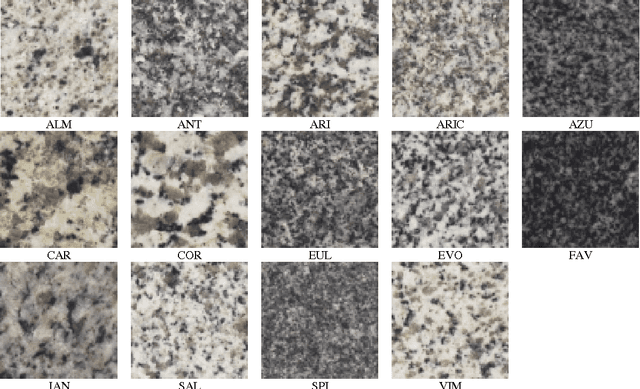
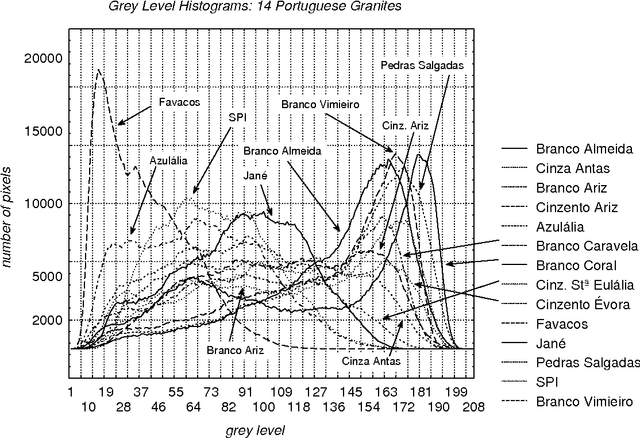
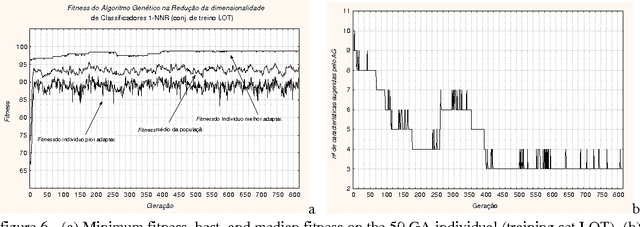
Abstract:The present paper deals with optimisation of Nearest Neighbour rule Classifiers via Genetic Algorithms. The methodology consists on implement a Genetic Algorithm capable of search the input feature space used by the NNR classifier. Results show that is adequate to perform feature reduction and simultaneous improve the Recognition Rate. Some practical examples prove that is possible to Recognise Portuguese Granites in 100%, with only 3 morphological features (from an original set of 117 features), which is well suited for real time applications. Moreover, the present method represents a robust strategy to understand the proper nature of the images treated, and their discriminant features. KEYWORDS: Feature Reduction, Genetic Algorithms, Nearest Neighbour Rule Classifiers (k-NNR).
* 9 pages, 7 figures, Author at http://alfa.ist.utl.pt/~cvrm/staff/vramos/ref_13.html
From Feature Extraction to Classification: A multidisciplinary Approach applied to Portuguese Granites
Dec 17, 2004

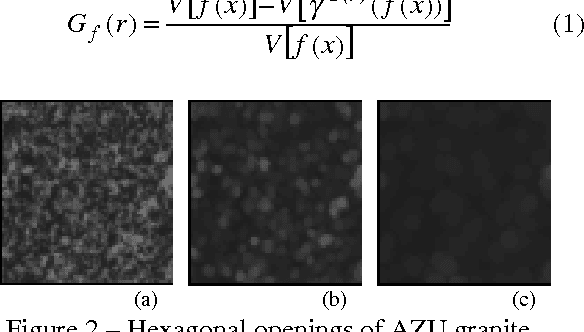
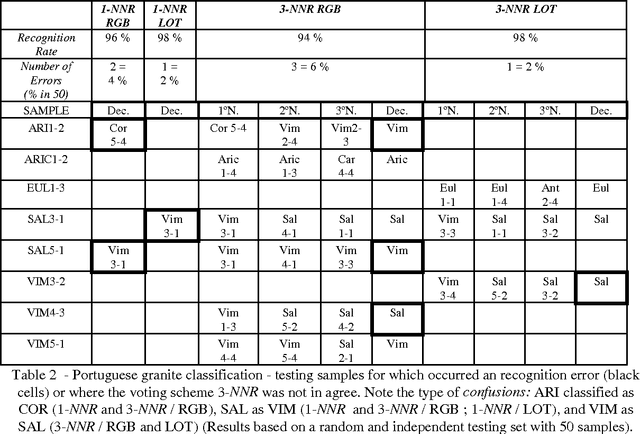
Abstract:The purpose of this paper is to present a complete methodology based on a multidisciplinary approach, that goes from the extraction of features till the classification of a set of different portuguese granites. The set of tools to extract the features that characterise polished surfaces of the granites is mainly based on mathematical morphology. The classification methodology is based on a genetic algorithm capable of search the input feature space used by the nearest neighbour rule classifier. Results show that is adequate to perform feature reduction and simultaneous improve the recognition rate. Moreover, the present methodology represents a robust strategy to understand the proper nature of the images treated, and their discriminant features. KEYWORDS: Portuguese grey granites, feature extraction, mathematical morphology, feature reduction, genetic algorithms, nearest neighbour rule classifiers (k-NNR).
* 8 pages, 6 figures, Author at http://alfa.ist.utl.pt/~cvrm/staff/vramos/ref_21.html
On Image Filtering, Noise and Morphological Size Intensity Diagrams
Dec 17, 2004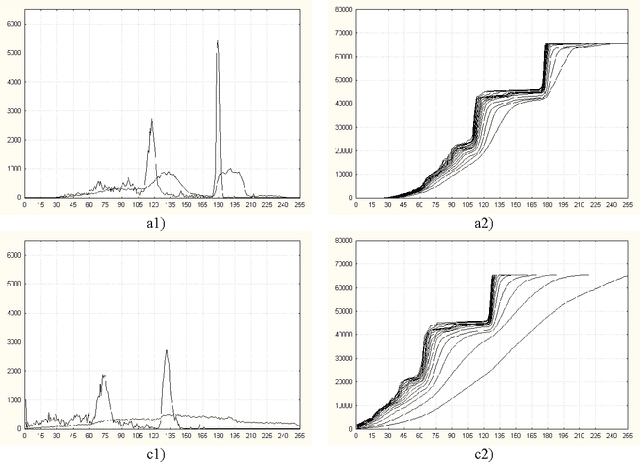

Abstract:In the absence of a pure noise-free image it is hard to define what noise is, in any original noisy image, and as a consequence also where it is, and in what amount. In fact, the definition of noise depends largely on our own aim in the whole image analysis process, and (perhaps more important) in our self-perception of noise. For instance, when we perceive noise as disconnected and small it is normal to use MM-ASF filters to treat it. There is two evidences of this. First, in many instances there is no ideal and pure noise-free image to compare our filtering process (nothing but our self-perception of its pure image); second, and related with this first point, MM transformations that we chose are only based on our self - and perhaps - fuzzy notion. The present proposal combines the results of two MM filtering transformations (FT1, FT2) and makes use of some measures and quantitative relations on their Size/Intensity Diagrams to find the most appropriate noise removal process. Results can also be used for finding the most appropriate stop criteria, and the right sequence of MM operators combination on Alternating Sequential Filters (ASF), if these measures are applied, for instance, on a Genetic Algorithm's target function.
* 9 pages, 4 figures, Author at http://alfa.ist.utl.pt/~cvrm/staff/vramos/ref_25.html
Image Colour Segmentation by Genetic Algorithms
Dec 17, 2004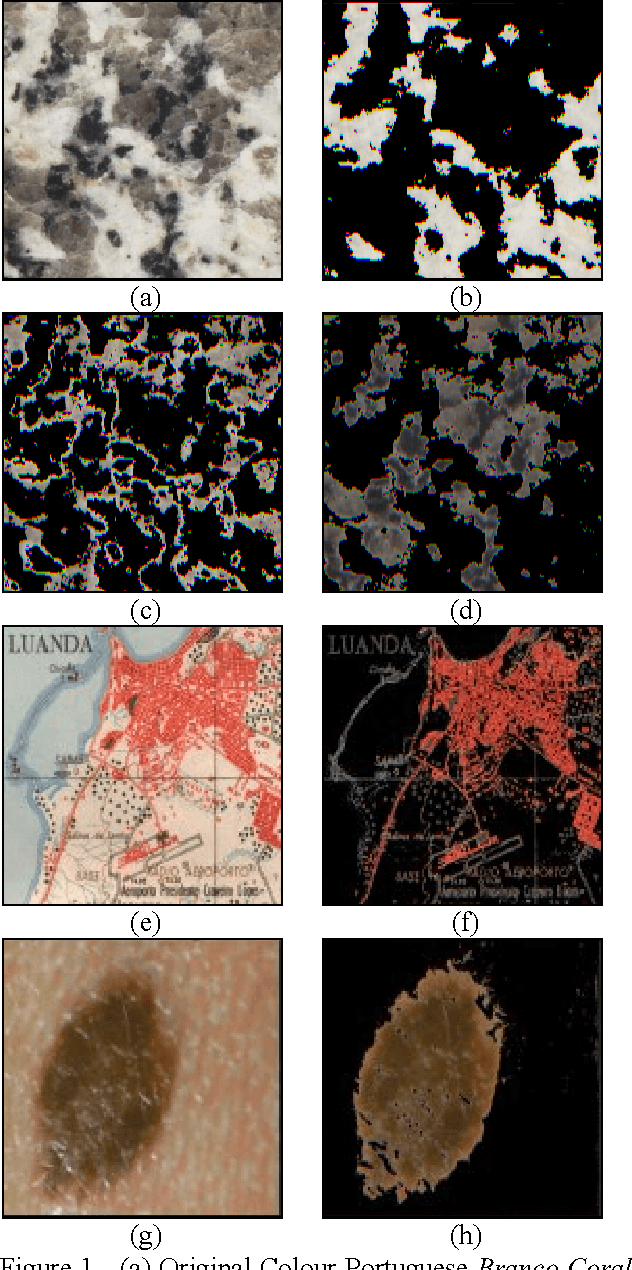
Abstract:Segmentation of a colour image composed of different kinds of texture regions can be a hard problem, namely to compute for an exact texture fields and a decision of the optimum number of segmentation areas in an image when it contains similar and/or unstationary texture fields. In this work, a method is described for evolving adaptive procedures for these problems. In many real world applications data clustering constitutes a fundamental issue whenever behavioural or feature domains can be mapped into topological domains. We formulate the segmentation problem upon such images as an optimisation problem and adopt evolutionary strategy of Genetic Algorithms for the clustering of small regions in colour feature space. The present approach uses k-Means unsupervised clustering methods into Genetic Algorithms, namely for guiding this last Evolutionary Algorithm in his search for finding the optimal or sub-optimal data partition, task that as we know, requires a non-trivial search because of its intrinsic NP-complete nature. To solve this task, the appropriate genetic coding is also discussed, since this is a key aspect in the implementation. Our purpose is to demonstrate the efficiency of Genetic Algorithms to automatic and unsupervised texture segmentation. Some examples in Colour Maps, Ornamental Stones and in Human Skin Mark segmentation are presented and overall results discussed. KEYWORDS: Genetic Algorithms, Colour Image Segmentation, Classification, Clustering.
* 5 pages, 1 figure, Author at http://alfa.ist.utl.pt/~cvrm/staff/vramos/ref_26.html
Map Segmentation by Colour Cube Genetic K-Mean Clustering
Dec 17, 2004
Abstract:Segmentation of a colour image composed of different kinds of texture regions can be a hard problem, namely to compute for an exact texture fields and a decision of the optimum number of segmentation areas in an image when it contains similar and/or unstationary texture fields. In this work, a method is described for evolving adaptive procedures for these problems. In many real world applications data clustering constitutes a fundamental issue whenever behavioural or feature domains can be mapped into topological domains. We formulate the segmentation problem upon such images as an optimisation problem and adopt evolutionary strategy of Genetic Algorithms for the clustering of small regions in colour feature space. The present approach uses k-Means unsupervised clustering methods into Genetic Algorithms, namely for guiding this last Evolutionary Algorithm in his search for finding the optimal or sub-optimal data partition, task that as we know, requires a non-trivial search because of its NP-complete nature. To solve this task, the appropriate genetic coding is also discussed, since this is a key aspect in the implementation. Our purpose is to demonstrate the efficiency of Genetic Algorithms to automatic and unsupervised texture segmentation. Some examples in Colour Maps are presented and overall results discussed. KEYWORDS: Genetic Algorithms, Artificial Neoteny, Dynamic Mutation Rates, Faster Convergence, Colour Image Segmentation, Classification, Clustering.
* 4 pages, 1 figure, Author at http://alfa.ist.utl.pt/~cvrm/staff/vramos/ref_31.html
 Add to Chrome
Add to Chrome Add to Firefox
Add to Firefox Add to Edge
Add to Edge